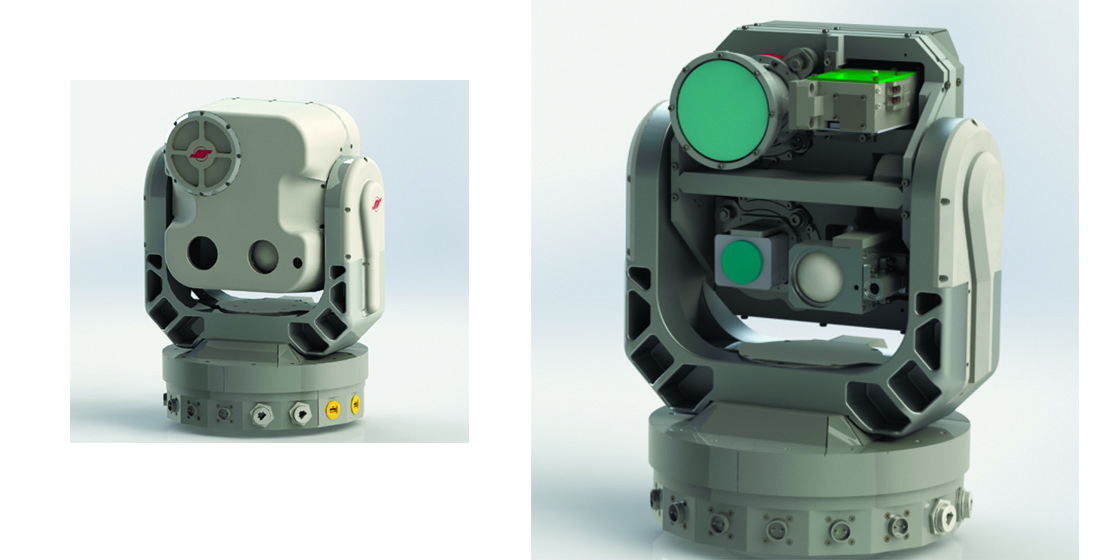Розроблення і випробування дослідного зразка оптико-електронної станції виявлення та супроводу рухомих об’єктів у повітряному середовищі
DOI:
https://doi.org/10.15587/1729-4061.2023.295101Ключові слова:
оптико-електронна станція, опорно-поворотний пристрій, керування сервоприводами, програмний методАнотація
Об’єктом дослідження є процес виявлення і супроводу повітряних цілій.
Вирішується проблема вибору пріоритетів між апаратними та програмними рішеннями усунення конструктивних протиріч при розробці опорно-поворотного пристрою, що водночас повинні забезпечити для оптико-електронної станції високу швидкість і точність супроводу повітряних об’єктів.
Розроблено та побудовано дослідний зразок оптико-електронної станції. Проведено дослідження впливу усунення конструктивних протиріч апаратними та програмними методами на характеристики точності опорно-поворотного пристрою. Створено власне спеціалізоване програмне забезпечення для тестування точності виконання команд. Розроблена методика випробувань оптико-електронної станції. Усі проведені випробування були виконані з дотриманням прийнятих норм та стандартів.
Встановлено механізм впливу методу керування сервоприводами опорно-поворотного пристрою на характеристики оптико-електронної станції. У цьому випадку пріоритет має програмний метод. На відміну від існуючих рішень розроблений програмний метод управління опорно-поворотним пристроєм дозволяє виключити зупинки на межах періоду управління сервоприводом та реалізувати плавний перехід на нове значення швидкості супроводу. Завдяки покращенню прогнозування та синхронізації параметрів сервоприводу із періодом його управління вдалося вирішити досліджувану проблему програмним методом.
Встановлено механізм впливу інерційності опорно-поворотного пристрою на характеристики оптико-електронної станції. У цьому випадку пріоритет має апаратний метод.
Отримані результати можуть бути використані для покращення характеристик оптико-електронних станцій при виявленні та високоточному супроводі рухомих об’єктів в повітряному середовищі
Посилання
- Hepworth, J. H., Mouton, H. D. (2019). Systems Development of a Two-Axis Stabilised Platform to Facilitate Astronomical Observations from a Moving Base. 2019 Southern African Universities Power Engineering Conference/Robotics and Mechatronics/Pattern Recognition Association of South Africa (SAUPEC/RobMech/PRASA). doi: https://doi.org/10.1109/robomech.2019.8704853
- Liang, Y., Pan, S Chen, L. (2023). Design of Optoelectronic Tracking Platform Driven by Ultrasonic Motor with a Novel Limiter. Micromachines, 14 (11), 2067. doi: https://doi.org/10.3390/mi14112067
- Zhang, B., Wang, Z., Wang, T. (2019). Development of two-axis non-magnetic turntable based on ultrasonic motor. Advances in Mechanical Engineering, 11 (3), 168781401982858. doi: https://doi.org/10.1177/1687814019828582
- Sheu, B.-H., Chiu, C.-C., Lu, W.-T., Huang, C.-I., Chen, W.-P. (2019). Development of UAV Tracking and Coordinate Detection Method Using a Dual-Axis Rotary Platform for an Anti-UAV System. doi: https://doi.org/10.20944/preprints201906.0146.v1
- Zhou, X., Li, X. (2021). Trajectory Tracking Control for Electro-Optical Tracking System Using ESO Based Fractional- Order Sliding Mode Control. IEEE Access, 9, 45891–45902. doi: https://doi.org/10.1109/access.2021.3067680
- Wang, Y., Sui, X., Zhang, T., Nie, T., Chen, C. (2023). Design and Experimental Study on the Torque Balancing Mechanism of a Satellite-Borne Two-Axis Rotary Table. Machines, 11 (8), 830. doi: https://doi.org/10.3390/machines11080830
- Chu, W., Zhang, B., Liu, B., Gui, Z., Zhao, D. (2019). An Optoelectronic Targeting System for Measuring the Distribution of Projectile Motion Based on the Subdivision of a Light Screen. Photonics, 6 (4), 126. doi: https://doi.org/10.3390/photonics6040126
- Affan Ahmed, S., Mohsin, M., Zubair Ali, S. M. (2021). Survey and technological analysis of laser and its defense applications. Defence Technology, 17 (2), 583–592. doi: https://doi.org/10.1016/j.dt.2020.02.012
- Tevyashev, A., Shostko, I., Neofitnyi, M., Koliadin, A. (2019). Laser Opto-Electronic Airspace Monitoring System in the Visible and Infrared Ranges. 2019 IEEE 5th International Conference Actual Problems of Unmanned Aerial Vehicles Developments (APUAVD). doi: https://doi.org/10.1109/apuavd47061.2019.8943887
- Shostko, I., Tevyashev, A., Kulia, Y., Koliadin, A. (2020). Optical-Electronic System of Automatic Detection and High-Precise Tracking of Aerial Objects in Real-Time. Third International Workshop on Computer Modeling and Intelligent Systems (CMIS-2020). Vol-2608. Zaporizhzhia, 784–803. Available at: https://ceur-ws.org/Vol-2608/paper59.pdf

##submission.downloads##
Опубліковано
Як цитувати
Номер
Розділ
Ліцензія
Авторське право (c) 2023 Ihor Shostko, Andriy Tevyashev, Oleg Zemlyaniy, Dmytro Tsibulnikov

Ця робота ліцензується відповідно до Creative Commons Attribution 4.0 International License.
Закріплення та умови передачі авторських прав (ідентифікація авторства) здійснюється у Ліцензійному договорі. Зокрема, автори залишають за собою право на авторство свого рукопису та передають журналу право першої публікації цієї роботи на умовах ліцензії Creative Commons CC BY. При цьому вони мають право укладати самостійно додаткові угоди, що стосуються неексклюзивного поширення роботи у тому вигляді, в якому вона була опублікована цим журналом, але за умови збереження посилання на першу публікацію статті в цьому журналі.
Ліцензійний договір – це документ, в якому автор гарантує, що володіє усіма авторськими правами на твір (рукопис, статтю, тощо).
Автори, підписуючи Ліцензійний договір з ПП «ТЕХНОЛОГІЧНИЙ ЦЕНТР», мають усі права на подальше використання свого твору за умови посилання на наше видання, в якому твір опублікований. Відповідно до умов Ліцензійного договору, Видавець ПП «ТЕХНОЛОГІЧНИЙ ЦЕНТР» не забирає ваші авторські права та отримує від авторів дозвіл на використання та розповсюдження публікації через світові наукові ресурси (власні електронні ресурси, наукометричні бази даних, репозитарії, бібліотеки тощо).
За відсутності підписаного Ліцензійного договору або за відсутністю вказаних в цьому договорі ідентифікаторів, що дають змогу ідентифікувати особу автора, редакція не має права працювати з рукописом.
Важливо пам’ятати, що існує і інший тип угоди між авторами та видавцями – коли авторські права передаються від авторів до видавця. В такому разі автори втрачають права власності на свій твір та не можуть його використовувати в будь-який спосіб.










